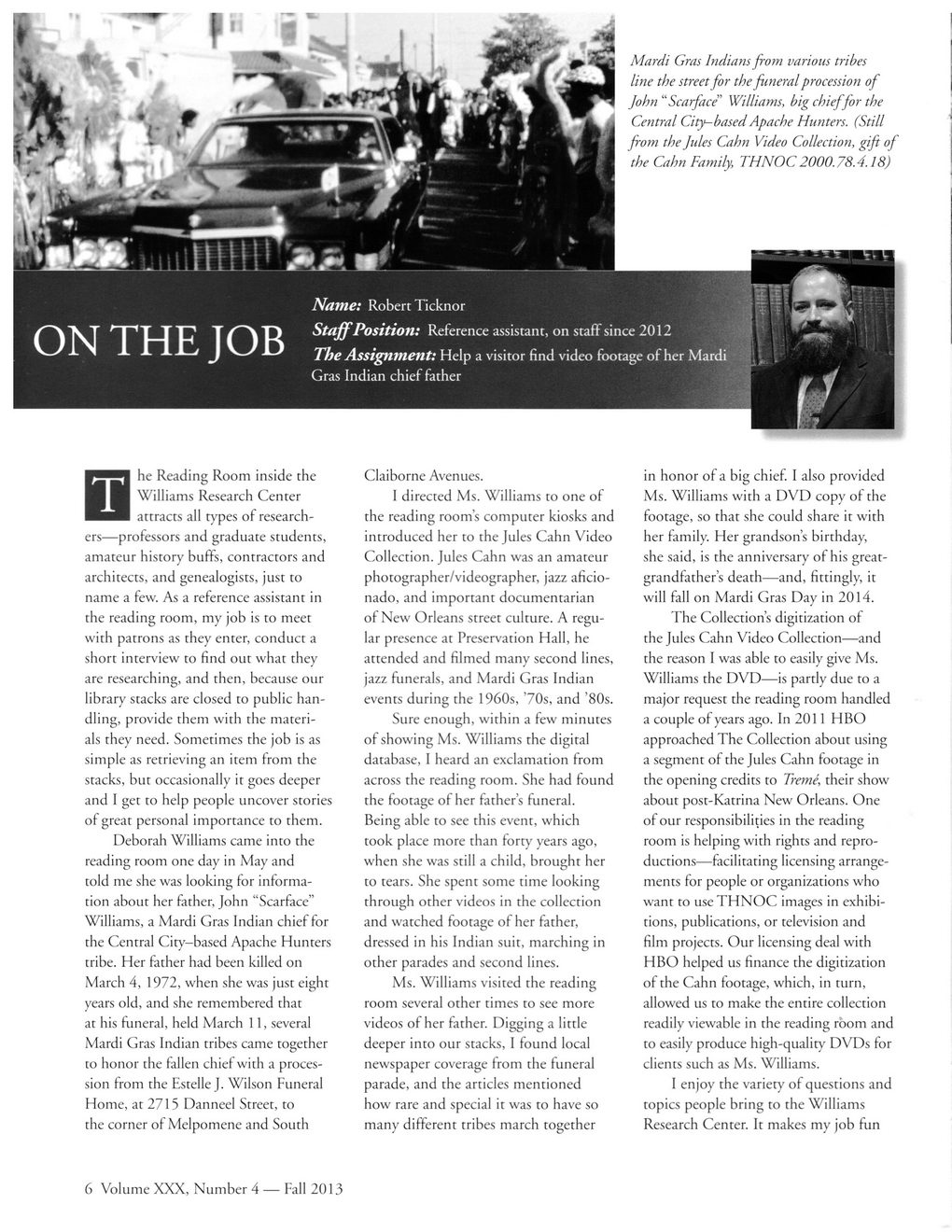This text was obtained via automated optical character recognition.
It has not been edited and may therefore contain several errors.
Mardi Gras Indians from various tribes line the street for the funeral procession of John“ Scarf ace' Williams, big chief for the Central City-based Apache Hunters. (Still from the Jules Cahn Video Collection, gift of the Cahn Family, THNOC 2000.78.4.18) The Reading Room inside the Williams Research Center attracts all types of researchers—professors and graduate students, amateur history buffs, contractors and architects, and genealogists, just to name a few. As a reference assistant in the reading room, my job is to meet with patrons as they enter, conduct a short interview to find out what they are researching, and then, because our library stacks are closed to public handling, provide them with the materials they need. Sometimes the job is as simple as retrieving an item from the stacks, but occasionally it goes deeper and I get to help people uncover stories of great personal importance to them. Deborah Williams came into the reading room one day in May and told me she was looking for information about her father, John “Scarface” Williams, a Mardi Gras Indian chief for the Central City-based Apache Hunters tribe. Her father had been killed on March 4, 1972, when she was just eight years old, and she remembered that at his funeral, held March 11, several Mardi Gras Indian tribes came together to honor the fallen chief with a procession from the Estelle J. Wilson Funeral Home, at 2715 Danneel Street, to the corner of Melpomene and South Claiborne Avenues. I directed Ms. Williams to one of the reading room’s computer kiosks and introduced her to the Jules Cahn Video Collection. Jules Cahn was an amateur photographer/videographer, jazz aficionado, and important documentarian of New Orleans street culture. A regular presence at Preservation Hall, he attended and filmed many second lines, jazz funerals, and Mardi Gras Indian events during the 1960s, ’70s, and ’80s. Sure enough, within a few minutes of showing Ms. Williams the digital database, I heard an exclamation from across the reading room. She had found the footage of her father’s funeral. Being able to see this event, which took place more than forty years ago, when she was still a child, brought her to tears. She spent some time looking through other videos in the collection and watched footage of her father, dressed in his Indian suit, marching in other parades and second lines. Ms. Williams visited the reading room several other times to see more videos of her father. Digging a little deeper into our stacks, I found local newspaper coverage from the funeral parade, and the articles mentioned how rare and special it was to have so many different tribes march together in honor of a big chief. I also provided Ms. Williams with a DVD copy of the footage, so that she could share it with her family. Her grandson’s birthday, she said, is the anniversary of his greatgrandfather’s death—and, fittingly, it will fall on Mardi Gras Day in 2014. The Collection’s digitization of the Jules Cahn Video Collection—and the reason I was able to easily give Ms. Williams the DVD—is partly due to a major request the reading room handled a couple of years ago. In 2011 HBO approached The Collection about using a segment of the Jules Cahn footage in the opening credits to Treme, their show about post-Katrina New Orleans. One of our responsibilities in the reading room is helping with rights and reproductions—facilitating licensing arrangements for people or organizations who want to use THNOC images in exhibitions, publications, or television and film projects. Our licensing deal with HBO helped us finance the digitization of the Cahn footage, which, in turn, allowed us to make the entire collection readily viewable in the reading room and to easily produce high-quality DVDs for clients such as Ms. Williams. I enjoy the variety of questions and topics people bring to the Williams Research Center. It makes my job fun 6 Volume XXX, Number 4 — Fall 2013

New Orleans Quarterly 2013 Fall (06)